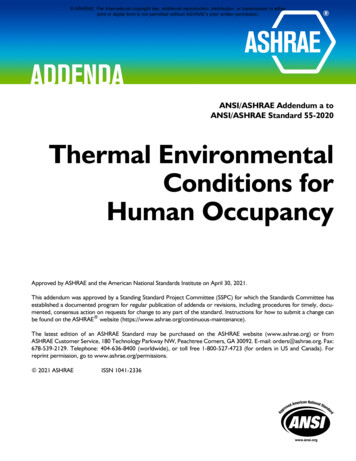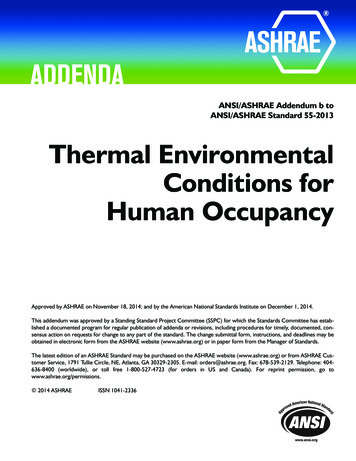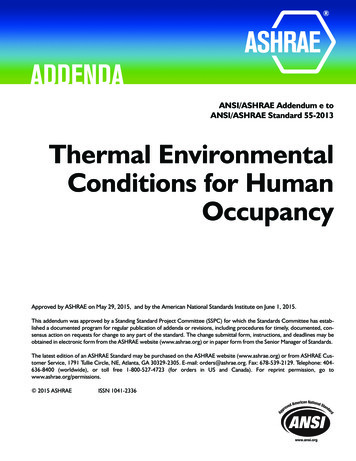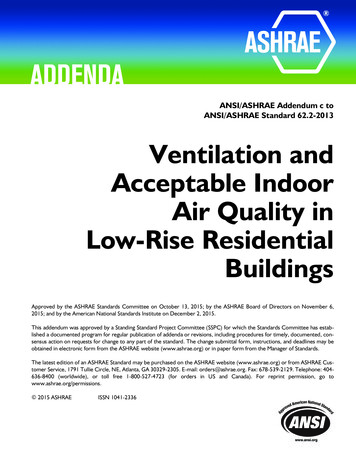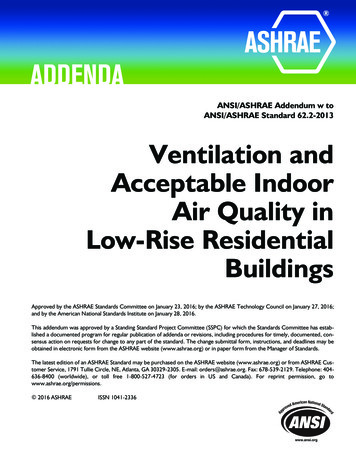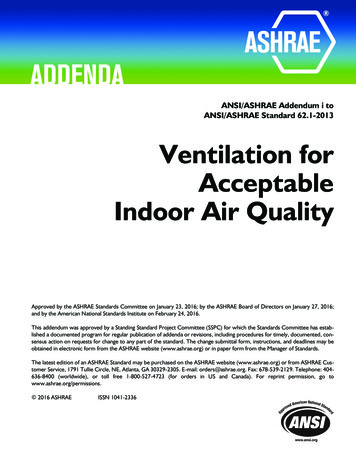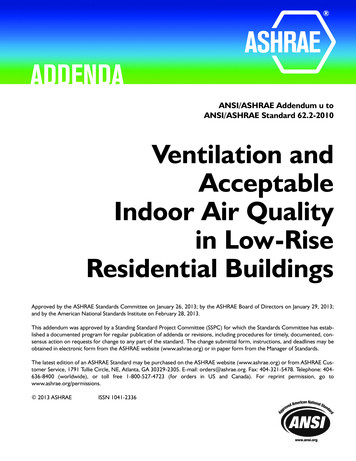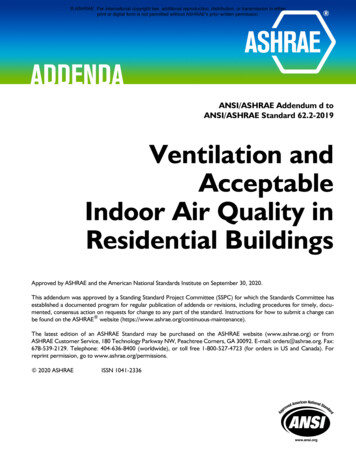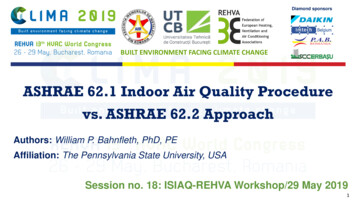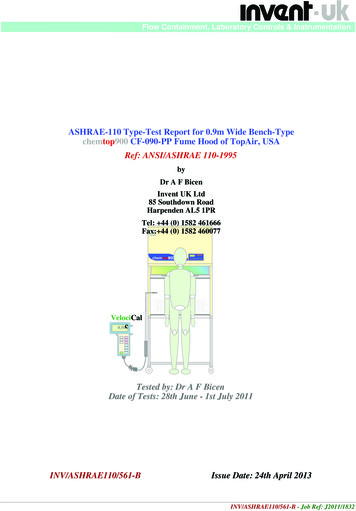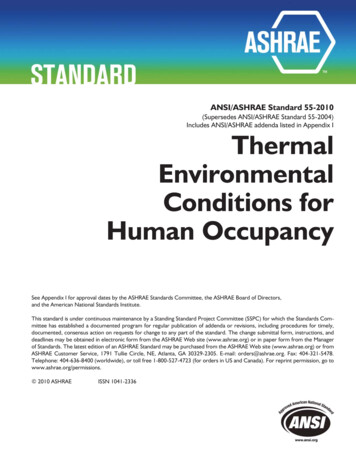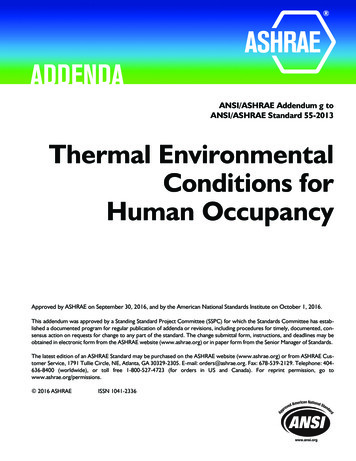
Transcription
ANSI/ASHRAE Addendum g toANSI/ASHRAE Standard 55-2013Thermal EnvironmentalConditions forHuman OccupancyApproved by ASHRAE on September 30, 2016, and by the American National Standards Institute on October 1, 2016.This addendum was approved by a Standing Standard Project Committee (SSPC) for which the Standards Committee has established a documented program for regular publication of addenda or revisions, including procedures for timely, documented, consensus action on requests for change to any part of the standard. The change submittal form, instructions, and deadlines may beobtained in electronic form from the ASHRAE website (www.ashrae.org) or in paper form from the Senior Manager of Standards.The latest edition of an ASHRAE Standard may be purchased on the ASHRAE website (www.ashrae.org) or from ASHRAE Customer Service, 1791 Tullie Circle, NE, Atlanta, GA 30329-2305. E-mail: orders@ashrae.org. Fax: 678-539-2129. Telephone: 404636-8400 (worldwide), or toll free 1-800-527-4723 (for orders in US and Canada). For reprint permission, go towww.ashrae.org/permissions. 2016 ASHRAEISSN 1041-2336
ASHRAE (www.ashrae.org). For personal use only. Additional reproduction, distribution,or transmission in either print or digital form is not permitted without ASHRAE's prior written permission.ASHRAE Standing Standard Project Committee 55Cognizant TC: 2.1, Physiology and Human EnvironmentSPLS Liaison: John F. DunlapAbhijeet Pande*, ChairJosh Eddy*, SecretaryPeter F. Alspach*Edward A. Arens*Robert Bean*Gail S. BragerRichard de DearPhilip Farese*Thomas B. Hartman*Michael A. HumphreysDaniel Int-Hout, IIIEssam E. Khalil*Thomas Lesser*, WebmasterBaizhan LiRodrigo Mora*Francis J. Offermann*Michael P. O’RourkeGwelen PaliagaZaccary A. Poots*Julian Rimmer*Lawrence J. Schoen*Stefano SchiavonMichael Tillou*Stephen C. Turner*John G. Williams** Denotes members of voting status when the document was approved for publicationASHRAE STANDARDS COMMITTEE 2016–2017Rita M. Harrold, ChairSteven J. Emmerich, Vice-ChairJames D. AsweganNiels BidstrupDonald M. BrundageDrury B. CrawleyJohn F. Dunlap,James W. Earley, Jr.Keith I. EmersonJulie M. FergusonMichael W. GallagherWalter T. GrondzikVinod P. GuptaSusanna S. HansonRoger L. HedrickRick M. HeidenSrinivas KatipamulaCesar L. LimArsen K. MelikovR. Lee Millies, Jr.Cyrus H. NasseriDavid RobinPeter SimmondsDennis A. StankeWayne H. Stoppelmoor, Jr.Jack H. ZarourWilliam F. Walter, BOD ExOPatricia Graef, COStephanie C. Reiniche, Senior Manager of StandardsSPECIAL NOTEThis American National Standard (ANS) is a national voluntary consensus Standard developed under the auspices of ASHRAE. Consensus is definedby the American National Standards Institute (ANSI), of which ASHRAE is a member and which has approved this Standard as an ANS, as“substantial agreement reached by directly and materially affected interest categories. This signifies the concurrence of more than a simple majority,but not necessarily unanimity. Consensus requires that all views and objections be considered, and that an effort be made toward their resolution.”Compliance with this Standard is voluntary until and unless a legal jurisdiction makes compliance mandatory through legislation.ASHRAE obtains consensus through participation of its national and international members, associated societies, and public review.ASHRAE Standards are prepared by a Project Committee appointed specifically for the purpose of writing the Standard. The ProjectCommittee Chair and Vice-Chair must be members of ASHRAE; while other committee members may or may not be ASHRAE members, allmust be technically qualified in the subject area of the Standard. Every effort is made to balance the concerned interests on all Project Committees.The Senior Manager of Standards of ASHRAE should be contacted fora. interpretation of the contents of this Standard,b. participation in the next review of the Standard,c. offering constructive criticism for improving the Standard, ord. permission to reprint portions of the Standard.DISCLAIMERASHRAE uses its best efforts to promulgate Standards and Guidelines for the benefit of the public in light of available information and acceptedindustry practices. However, ASHRAE does not guarantee, certify, or assure the safety or performance of any products, components, or systemstested, installed, or operated in accordance with ASHRAE’s Standards or Guidelines or that any tests conducted under its Standards or Guidelineswill be nonhazardous or free from risk.ASHRAE INDUSTRIAL ADVERTISING POLICY ON STANDARDSASHRAE Standards and Guidelines are established to assist industry and the public by offering a uniform method of testing for rating purposes, bysuggesting safe practices in designing and installing equipment, by providing proper definitions of this equipment, and by providing other informationthat may serve to guide the industry. The creation of ASHRAE Standards and Guidelines is determined by the need for them, and conformanceto them is completely voluntary.In referring to this Standard or Guideline and in marking of equipment and in advertising, no claim shall be made, either stated or implied,that the product has been approved by ASHRAE.ASHRAE is a registered trademark of the American Society of Heating, Refrigerating and Air-Conditioning Engineers, Inc.ANSI is a registered trademark of the American National Standards Institute.
ASHRAE (www.ashrae.org). For personal use only. Additional reproduction, distribution,or transmission in either print or digital form is not permitted without ASHRAE's prior written permission.(This foreword is not part of this standard. It is merelyinformative and does not contain requirements necessaryfor conformance to the standard. It has not been processed according to the ANSI requirements for a standardand may contain material that has not been subject topublic review or a consensus process. Unresolved objectors on informative material are not offered the right toappeal at ASHRAE or ANSI.)FOREWORDThis addendum adds a requirement to calculate the change tothermal comfort resulting from direct solar radiation impacting occupants. A calculation procedure is added in new Normative Appendix C, “Procedure for Calculating ComfortImpact of Solar Gain on Occupants.” The procedure inAppendix C results in an adjustment to mean radiant temperature (MRT) due to direct solar radiation so that the Standard 55 comfort zone calculation remains unchanged (i.e., thesame six inputs are required). With this change, the GraphicComfort Zone Method in Section 5.3.1 is restricted to conditions without direct solar radiation. When direct solar radiation is present and impacts a representative occupant, theAnalytical Comfort Zone Method in Section 5.3.2 must beused. Section 5.3.2 provides prescriptive and performancecompliance paths. Prescriptive tables in Section 5.3.2 covermany common applications and allow an MRT increase of2.8 C (5 F) to be used if all criteria in Section 5.3.2.2.1(b)are met. The performance approach uses the calculation procedure in Section 5.3.2.2.1(a) and can be used for any application.Normative Appendix C describes the calculation procedure and includes a computer code implementation. The CBEThermal Comfort Tool (http://comfort.cbe.berkeley.edu) provides an online implementation of the method under the “SolarCal” button.Note: In this addendum, changes to the current standardare indicated in the text by underlining (for additions) andstrikethrough (for deletions) unless the instructions specifically mention some other means of indicating the changes.Addendum g to Standard 55-2013Revise Section 3 as shown. The remainder of Section 3 isunchanged.3. DEFINITIONSsolar transmittance, total (Tsol): total solar radiation transmittance through a fenestration unit, including glazing unitand internal blinds or shades. See Normative Appendix C foracceptable calculation methods.temperature, mean radiant ( t r ): the temperature of a uniform, black enclosure that exchanges the same amount of heatby radiation with the occupant as the actual enclosuresurroundings. It is a single value for the entire body and accountsfor both long-wave mean radiant temperature ( t rlw ) andshort-wave mean radiant temperature ( t rsw ). expressed as aspatial average of the temperature of surfaces surrounding theoccupant weighted by their view factors with respect to theANSI/ASHRAE Addendum g to ANSI/ASHRAE Standard 55-2013occupant. (See Chapter 9 of ASHRAE Handbook—Fundamentals3 for a more complete description of mean radianttemperature.)temperature, long-wave mean radiant ( t rlw ): Radiant temperature from long-wave radiation from interior surfacesexpressed as a spatial average of the temperature of surfacessurrounding the occupant, weighted by their view factors withrespect to the occupant. (See ASHRAE Handbook—Fundamentals3, Chapter 9).temperature, short-wave mean radiant ( t rsw ): Radiant temperature from short-wave direct and diffuse solar radiationexpressed as an adjustment to long-wave mean radiant temperature ( t rlw ) using the calculation procedure in NormativeAppendix C of this standard.shade openness factor: percentage of the area of a shade orblind material that is unobstructed. For woven shades, shadeopenness factor is the weave openness.direct-beam solar radiation: solar radiation from the direction of the sun, expressed in W/m2 (Btuh/ft2). Does notinclude reflected or diffuse solar radiation. Also known asdirect normal insolation (Idir).Revise Section 5.3.1 as shown. The remainder of Section5.3.1 is unchanged.5.3.1 Graphic Comfort Zone Method5.3.1.1 Applicability. Use of this method shall be limitedto representative occupants with metabolic rates between 1.0and 1.3 met and clothing insulation (Icl) between 0.5 and 1.0clo and who are not exposed to direct-beam solar radiation.Average air speed (Va) greater than 0.2 m/s (40 fpm) requiresthe use of Section 5.3.3.The Graphic Comfort Zone is limited to a humidity ratioat or below 0.012 kg·H2O/kg dry air (0.012 lb·H2O/lb dryair), which corresponds to a water vapor pressure of 1.910kPa (0.277 psi) at standard pressure or a dew-point temperature of 16.8 C (62.2 F).Revise Section 5.3.2 as shown.5.3.2 Analytical Comfort Zone Method5.3.2.1 Applicability. It is permissible to apply themethod in this section to all spaces within the scope of thisstandard where the occupants have activity levels that resultin average metabolic rates between 1.0 and 2.0 met. Averageair speeds (Va) greater thatn 0.20 m/s (40 fpm) require the useof Section 5.3.3.5.3.2.2 Methodology. The computer code in NormativeAppendix B is to be used with this standard.4 Compliance isachieved if –0.5 PMV 0.5. Alternative methods are permitted. If any other method is used, it is the user’s responsibility to verify and document that the method used yields thesame results. The ASHRAE Thermal Comfort Tool4 is permitted to be used to comply with this section.5.3.2.2.1 When direct-beam solar radiation falls on arepresentative occupant, the mean radiant temperature ( t r )shall account for long-wave mean radiant temperature ( t rlw )1
ASHRAE (www.ashrae.org). For personal use only. Additional reproduction, distribution,or transmission in either print or digital form is not permitted without ASHRAE's prior written permission.and short-wave mean radiant temperature ( t rsw ) using one ofthe following options:a. Full calculation of mean radiant temperature ( t r ) as follows:1. Step 1: Determine long-wave mean radiant temperature ( t rlw ).2. Step 2: Determine short-wave mean radiant temperature ( t rsw ) using Normative Appendix C.3. Step 3: Mean radiant temperature ( t r ) is equal to ( t rlw t rsw ), as determined in Steps 1 and 2.b. Use a mean radiant temperature ( t r ) that is 2.8 C (5 F)higher than average air temperature (ta) if all of the following conditions are met:1. The space has air temperature stratification less thanSection 5.3.4.3.2. The space does not have active radiant surfaces.3. Building envelope opaque surfaces of the space (walls,floor, roof) meet U-factor prescriptive requirement ofASHRAE/IES Standard 90.17.24. Outdoor air temperature is less than 43 C (110 F).5. Vertical fenestration has less than 9 ft (3 m) totalheight.6. No skylights are present.7. The space complies with all requirements in a singlerow of Tables 5.3.2.2.1A, B, C or D. Interpolationbetween values within a single table (5.3.2.2.1A, B, C,or D), but not between tables, is permissible. Solarabsorptance properties for shade fabrics used in Tables5.3.2.2.1A, B, C, or D shall use the most similar colorfrom 5.3.2.2.1E unless more specific data are availablefrom the manufacturer.Tables 5.3.2.2.1A through D show criteria that allow useof mean radiant temperature ( t r ) that is 2.8 C (5 F) higherthan average air temperature (ta) for high-performance glazing units (Table 5.3.2.2.1A), clear low-performance glazingunits (5.3.2.2.1B), tinted glazing units (5.3.2.2.1C), and electrochromic glazing units (5.3.2.2.1D). See Normative Appendix C Section C2(e) for a description of fbes.ANSI/ASHRAE Addendum g to ANSI/ASHRAE Standard 55-2013
ASHRAE (www.ashrae.org). For personal use only. Additional reproduction, distribution,or transmission in either print or digital form is not permitted without ASHRAE's prior written permission.TABLE 5.3.2.2.1A High-Performance (Low-e) Glazing UnitsRepresentative OccupantDistance from Interior Windowor Shade Surface, ft (m)Glazing UnitFraction of BodyTotal SolarExposed to Sun (fbes), Transmission%(Tsol), %Glazing UnitIndirect SHGC(SHGC – Tsol),%Interior ShadeInterior ShadeSolar AbsorptanceOpenness Factor, of Window-Facing%Side, % 3.3 (1) 50 35 4.5 9 65 3.3 (1) 100 35 4.5 5 65TABLE 5.3.2.2.1B Clear Low-Performance Glazing UnitsRepresentative OccupantDistance from Interior Windowor Shade Surface, ft (m)Fraction of BodyExposed to Sun(fbes), %Glazing UnitTotal SolarTransmission(Tsol), %Glazing UnitIndirect SHGC(SHGC –
20.09.2016 · ANSI/ASHRAE Standard 55-2013 Thermal Environmental Conditions for Human Occupancy Approved by ASHRAE on September 30, 2016, and by the American National Standards Institute on October 1, 2016. This addendum was approved by a Standing Standard Project Committee (SSPC) for which the Standards Committee has estab-lished a documented program for regular publication of

